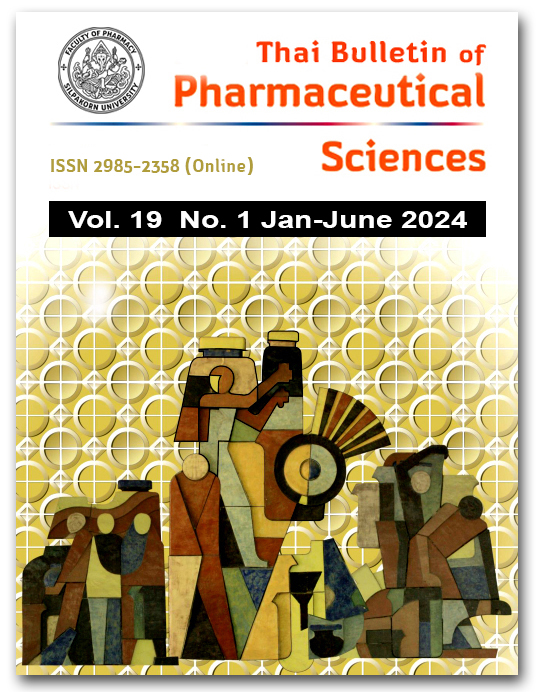INCIDENCE AND FACTORS ASSOCIATED WITH BLEEDING IN PATIENTS RECEIVING CONCOMITANT FIBRINOLYTIC AGENTS AND CORTICOSTEROIDS THERAPY
DOI:
https://doi.org/10.69598/tbps.19.1.53-65Keywords:
Thrombolytic agents, Steroids, Streptokinase, AlteplaseAbstract
Fibrinolytic agents are used to treat thromboembolism for several indications due to their efficacy. However, they can increase the risk of bleeding and type I hypersensitivity reactions. In clinical practice, the premedication strategy with corticosteroids was used to prevent these hypersensitivity reactions but may also increase the risk of bleeding. This retrospective cohort study analyzed the incidence and factors associated with bleeding in patients receiving concomitant fibrinolytic agents and corticosteroid therapy. Data were collected by electronic databases and medical records at Nakhon Pathom Hospital from January 2019 to July 2022 using a data collecting form. A total of 106 patients who received streptokinase or alteplase in combination with corticosteroids were bleeding in 14.3% and 44.8%, respectively. Factors associated with bleeding that are statistically significant include the history of cerebrovascular accident (OR 10.11, 95%CI 1.4 - 74.0, p-value 0.023), hypertension (OR 8.45, 95%CI 1.8 - 40.1, p-value 0.007) and receiving two corticosteroids (OR 6.07, 95%CI 1.3 - 28.3, p-value 0.022). Therefore, it is necessary for healthcare professionals to closely monitor the occurrence of bleeding in patients receiving fibrinolytic drugs and corticosteroids, especially among patients with these risk factors.
References
Baig MU, Bodle J. Thrombolytic therapy [Internet]. 2023 [cited 2023 May 5]; Available from: https://www.ncbi.nlm.nih.gov/books/NBK557411/
David CS, Robert MC. Complications of thrombolytic therapy. In: Eric RB, editor. Thrombolysis and adjunctive therapy for acute myocardial infarction. New York: Marcel Dekker; 1993. p. 91-115.
Duangmee K, Boonmuang P, Santimaleeworagun W, Prasitdumrong H. Urticaria, angioedema, and type I hypersensitivity reactions associated with fibrinolytic agents. Asian Pac J Allergy Immunol. 2022;40(4):379–85.
Prasitdumrong H, Duangmee K, Boonmuang P, Santimaleeworagun W, Oppamayun Y, Sonsupap C, et al. Incidence of urticaria, angioedema, and type I hypersensitivity reactions associated with fibrinolytic agents in Thailand using the database of the health product vigilance center. Asian Pac J Allergy Immunol. 2023;41(1):67–72.
Tseng CL, Chen YT, Huang CJ, Luo JC, Peng YL, Huang DF, et al. Short-term use of glucocorticoids and risk of peptic ulcer bleeding: A nationwide population-based case-crossover study. Aliment Pharmacol Ther. 2015;42(5):599–606.
Narum S, Westergren T, Klemp M. Corticosteroids and risk of gastrointestinal bleeding: A systematic review and meta-analysis. BMJ Open. 2014;4(5):e004587.
Mehran R, Rao SV, Bhatt DL, Gibson CM, Caixeta A, Eikelboom J, et al. Standardized bleeding definitions for cardiovascular clinical trials: A consensus report from the Bleeding Academic Research Consortium. Circulation. 2011;123(23):2736–47.
Huynh T, Cox JL, Massel D, Davies C, Hilbe J, Warnica W, et al. Predictors of intracranial hemorrhage with fibrinolytic therapy in unselected community patients: A report from the FASTRAK II project. Am Heart J. 2004;148(1):86–91.
Kongngern L. Risk factors of intracerebral hemorrhage after intravenous thrombolysis in acute ischemic stroke in Buriram Hospital. Med J Srisaket Surin Buriram Hosp. 2022;37:65-75. (in Thai)
Van de Werf F, Barron HV, Armstrong PW, Granger CB, Berioli S, Barbash G, et al. Incidence and predictors of bleeding events after fibrinolytic therapy with fibrin-specific agents: A comparison of TNK-tPA and rt-PA. Eur Heart J. 2001;22(24):2253–61.
Guo Y, Yang Y, Zhou M, He L. Risk factors of haemorrhagic transformation for acute ischaemic stroke in Chinese patients receiving intravenous recombinant tissue plasminogen activator: A systematic review and meta-analysis. Stroke Vasc Neurol. 2018;3(4):203–8.
Tsikouris JP, Tsikouris AP. A review of available fibrin-specific thrombolytic agents used in acute myocardial infarction. Pharmacotherapy. 2001;21(2):207–17.
McLeod DC, Coln WG, Thayer CF, Perfetto EM, Hartzema AG. Pharmacoepidemiology of bleeding events after use of r-alteplase or streptokinase in acute myocardial infarction. Ann Pharmacother. 1993;27(7-8):956–62.
Franchini M, Zaffanello M, Mannucci PM. Bleeding disorders in primary fibrinolysis. Int J Mol Sci. 2021;22(13):7027.
Downloads
Published
How to Cite
Issue
Section
License
All articles published and information contained in this journal such as text, graphics, logos and images is copyrighted by and proprietary to the Thai Bulletin of Pharmaceutical Sciences, and may not be reproduced in whole or in part by persons, organizations, or corporations other than the Thai Bulletin of Pharmaceutical Sciences and the authors without prior written permission.



